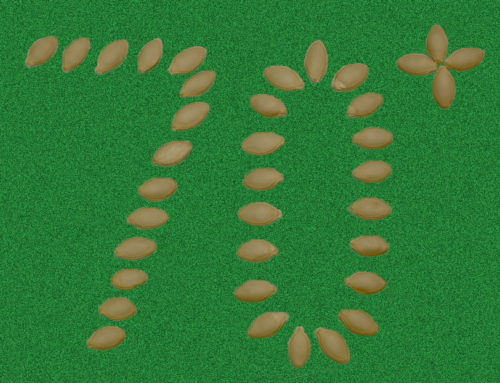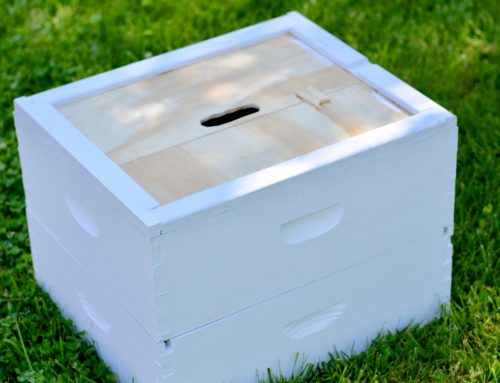I’ve gotten a number of questions recently about how to hand pollinate zucchini plants.
For those wondering, there are two main reasons one would wish to hand pollinate squash. The first is so that the plant will produce fruit. The second reason is to save pure seed that can be planted next year. Saving vegetable seeds from your garden can be very rewarding and is very important for preserving the genetic diversity of our food supply. However, hand pollinating for the purpose of saving seeds is more challenging than simply hand pollinating for the goal of producing fruit for eating. If you are interested in saving seeds, zucchinis are a great vegetable to start with and there are many resources available to learn the skill. This post focuses on hand pollination for fruit setting purposes only. The method described below can be used on any variety of squash in the cucurbitaceae family of vegetables.
So you planted your squash as soon as the Soil Temperature reached 70 degrees or so. Its been about a month and a half and your small seed has turned into a monster plant that seems to grow by the day. Pretty soon you start seeing flowers emerge, and then more flowers and more flowers, it appears that squashes are immanent. So you wait and wait but despite all the signs, a squash never appears. Why is that? To answer this frustrating question, we will need a basic plant biology lesson.
Step by Step: How to hand pollinate Cucurbitaceae spp. (Zucchini, Squash, Pumpkins, Cucumbers, and the like)
Step One
Do zucchini plants have male and female flowers? Yes! Identifying both male and female flowers is the first step to hand pollinating. It is quite easy to figure out the sex of squash plant blooms, even for a rookie. As shown in the picture, male flowers have long stems, clearly visible pollen grains on the stamen, and do not have an immature fruit at the base of the flower. Female flowers on the other hand, usually form low and close to the main stem of the plant and have an immature fruit at the base of the flower. The immature fruit resembles the adult version. For zucchini and squash plants, the immature fruit is oblong; for pumpkins and melons it is round. If you’re still having trouble identifying which is which, look at two different types of flowers from the same plant.
Assuming that you have been able to identify both male and female flowers on your plant and still aren’t getting any fruit, it’s possible your flowers are not getting pollinated. I personally have not experienced this issue, but it is conceivable that you might.

Male zucchini on the left. Female zucchini flower on the right. Notice the baby zucchini at the base of the female flower.
Step Two
Cut the male flowers at the base of the stem, near the vine. The male flower stems are most easily removed with scissors or a knife. This needs to be done early in the morning, preferably before 8 AM. Cucurbitaceae flowers open first thing in the morning and by lunchtime the window of opportunity is over because the flowers have closed and wilted. Only the open flowers have mature pollen that can be successfully used for pollination, so do not use immature or wilted flowers. The most successful hand pollinators use multiple male flowers from multiple plants to pollinate the females. That being said, if you only have one plant, don’t worry, one male flower usually has enough pollen to do the trick.
Step Three
Remove the petals of the male flowers. Do this carefully so that you don’t accidentally shake all of the pollen off of the stamen.

Male flower with petals removed, ready to “paint” the female flower.
Step Four
“Paint” the tips of the female flower stigma with the pollen from the male flowers. You should be able to see pollen grains sticking to the end of the stigma once you are finished.
That’s it, that’s all there is to it. If lack of pollination is your problem then this simple process will fix your issue. You will have squashes in no time by hand pollinating your plants.
While hand pollinating zucchini plants is incredibly easy, you may have found yourself unable to pollinate because your plant only has male flowers. Normally male flowers emerge first on cucurbitaceae plants. Male flowers can arrive up to two weeks before female flowers. If your plant just started blooming then most likely having a little patience will solve your problem. Other reasons for a lack of female flowers include: unseasonably cool or rainy weather, not enough sun, and nutrient imbalances. You may choose to try to correct these problems if you so desire, or just wait it out and see what happens!
If you want to learn more about hand pollination or seed saving I highly recommend the book Seed to Seed by Suzanne Ashworth. For more information check out my book review.
- Female pumpkin flower
- Male pumpkin flower
A few interesting tips and tricks.
- Zuchinni and Squash flowers can be eaten. Chickens enjoy them too.
- Many other vegetable families such as the tomato family have perfect flowers, meaning there are no male and female flowers. As a result the wind is often times enough to self-pollinate tomato plants. In commercial greenhouses bumblebees are generally used to pollinate tomato plants since wind isn’t present.
- Squash Bees (Peponapis Pruinosa) will only forage on flowers of the squash family of plants. Squash bees are native to the United States and are more effective at pollinating this family of vegetables than honey bees.
- Removing fruits when they are small will stimulate vegetable plants to produce more. The plant’s objective in life is to reproduce mature seeds. Zucchinis between 8 and 12 inches long not only taste the best, but they also have immature seeds. The plant will try to grow a fruit until it produces one with mature seeds. Once this happens the production of additional fruits slows down.







Leave A Comment